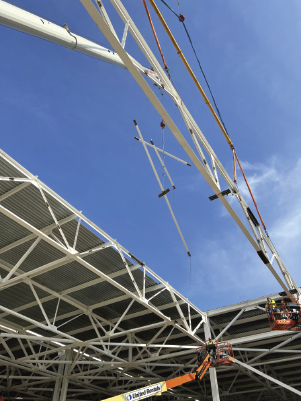Red Cedar Steel, a national steel erection contractor, recently topped out on a 3-million-square-foot industrial complex in Jurupa, California, using a new remote-controlled hook. OTH Pioneer Rigging’s LudwigHook below-the-hook lifting device is used to release loads from rigging safely from a distance, eliminating the need to manually unhook rigging.
LUDWIGHOOK SYSTEM
Red Cedar Steel was introduced to the LudwigHook system at the Ironworker Management Progressive Action Cooperative Trust (IMPACT) Conference in February 2022. Red Cedar Steel had the opportunity to do a free trial of the hooks at its headquarters in Wisconsin after the trade show and was immediately sold. One week later, the company purchased eight additional LudwigHook kits for Red Cedar Steel crews to use across the nation.
“From the moment I came across the hooks from OTH Pioneer Rigging, I knew it would be a game changer for steel erectors,” says Nick Martinez, general field superintendent for Red Cedar Steel. “So, when we were approached by Triad Fabricators to erect 1.5-million-square-feet of bar joists on six buildings for the Agua Mansa Industrial Park, I knew immediately that we needed to implement the hooks into the job.”
PROACTIVE APPROACH
Martinez took a proactive approach to introduce the new rigging tool to the other contractors and ironworkers on the job. “This is a revolutionary concept so I compiled all of the user manuals, product specs, and additional documentation to present to Triad Fabricators, and the project’s general contractor, KPRS Construction Service, Inc.,” says Martinez.
Due to the location of the project, the other contractors wanted assurance that the hook would meet Cal/OSHA guidelines. “When I looked into this further, I found that as long as we followed protocol for OSHA Subpart R, Cal/OSHA was not concerned about the use of the product on the jobsite,” says Martinez.
“To ensure compliance with U.S. and Canadian standards, OTH Pioneer Rigging conducted a comprehensive certification evaluation,” says Jeremy Poste, vice president of operations at OTH Pioneer Rigging. “We can provide a summary of the documents to contractors to satisfy any questions that arise,” he adds.
LudwigHooks comply with ASME B30.20 and meet OSHA 29 CFR 1926.251 requirements. The radio frequency remote control has received certificates of acceptance from the FCC in the United States and ISED in Canada. In addition, the user manual meets voluntary industry consensus standards found in ANSI Z535.4 and Z535.6.
“In addition, using these hooks helps contractors mitigate risks outlined in OSHA 29 CFR 1926.753(d) and 1926.1425(b), where the regulation specifies that employees shall not work below suspended loads,” says Poste.

HOOKS IN ACTION
Martinez gathered the project’s senior site superintendent from KPRS Construction Service, Inc., representatives of the Ironworkers District Safety Counsel, representatives from the crane rental company, the crane operators for the project, and the ironworkers from Ironworkers Local 433 to see the hooks in action. “That’s what sold our company on the use of the hooks so I knew I needed to demonstrate to others how beneficial the hooks could be,” says Martinez.
“It didn’t take long for everyone to see how revolutionary this product is, and the feedback I received after the demonstration was incredible. The senior site superintendent for KPRS was extremely impressed that ironworkers were able to safely release loads from the ground 200 feet away using a remote-control. They were immediately on board and wished the industry had something like this sooner,” says Martinez.
SAFETY, SPEED, PRODUCTIVITY
By the time Red Cedar Steel was given permission to use the hooks on the jobsite they were 20 days into the steel erection process. The company was responsible for erecting 60-foot joist girders that were approximately 7,500 lbs to 8,000 lbs each.
Red Cedar Steel utilized two 90-ton rough terrain cranes from Link-Belt with two LudwigHooks per crane to make the lifts. “Each LudwigHook has a working load limit of 4,400 lbs, so when you put two hooks together, the working load limit is actually 8,800 lbs. This allows users to create a customized solution to achieve scalable lifting capacity,” says Oliver Gleize, president of OTH Pioneer Rigging.
The remote control is color-coded to coordinate with hooks which allows users to open the hooks all at once or one at a time. The opening mechanism of the hook switches off when lifting over 55 lbs, ensuring that the load cannot be dropped during a lift. When the load is set down, the opening mechanism switches on allowing the user to release the hook through the remote control. Each remote control has a unique ID resulting in a unique code transmitted to the hooks in order to prevent a remote from controlling hooks from another kit if one is being used by another team nearby.
“Being able to eliminate the process of manually unhooking the rigging was a big reason for us to integrate the hooks into our process. Not only does it save time, there is a huge safety benefit. Safety is always at the top of mind so being able to keep our ironworkers out of the process is a big deal,” says Martinez.
During the course of this project, Red Cedar Steel estimated that each lift only took about three minutes to complete. The LudwigHook solution features a long-lasting battery life which is capable of making more than 100 lifts per day for a full week before recharging is required, and the hook remains locked if the battery is fully discharged.
CLOSING THOUGHT
“We had a very strict schedule for erecting the bar joists and using the hooks allowed us to stick to that schedule. Implementing the LudwigHooks was my biggest accomplishment of 2022 and now everyone wants to use the hooks for every project,” says Martinez.
For More Information:
For more information on LudwidHooks, visit ludwigsystem.com.
Modern Contractor Solutions, September 2023
Did you enjoy this article?
Subscribe to the FREE Digital Edition of Modern Contractor Solutions magazine.



